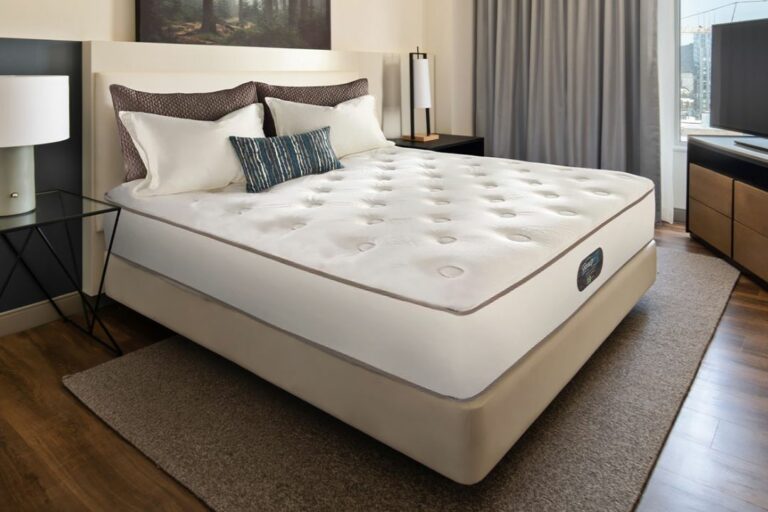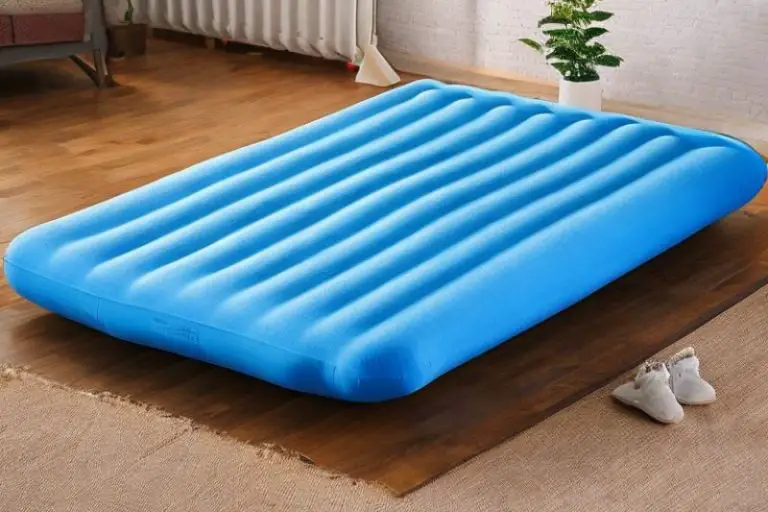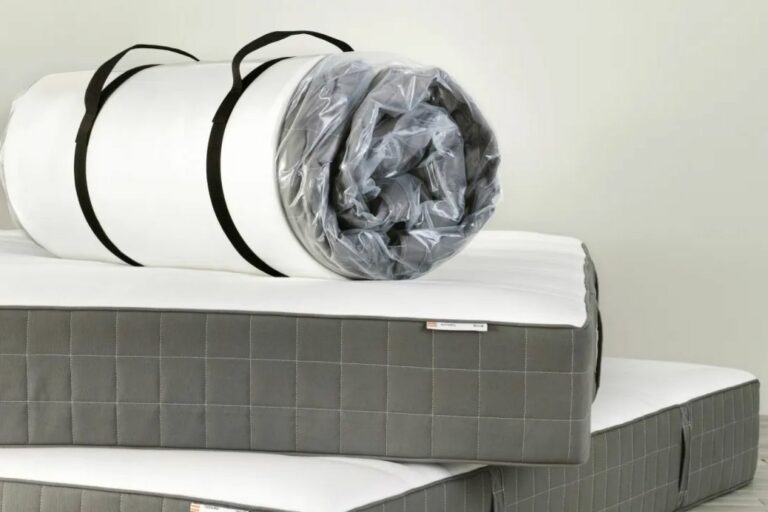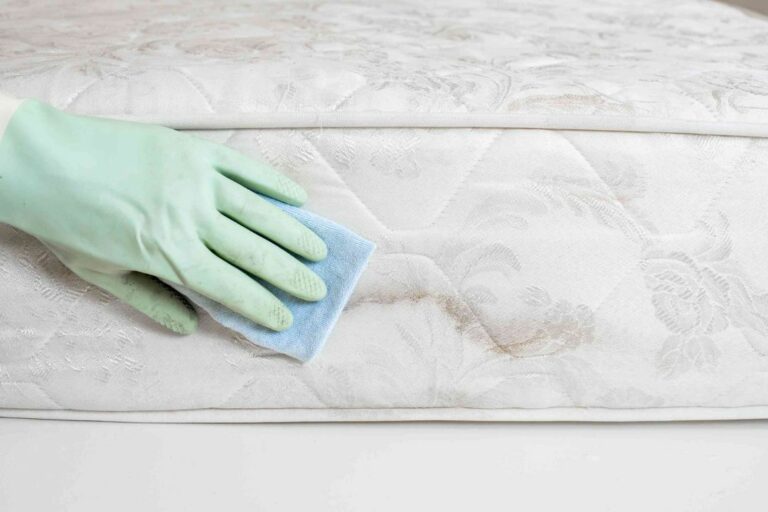Mattress With Fiberglass: (Potential Hazards!)
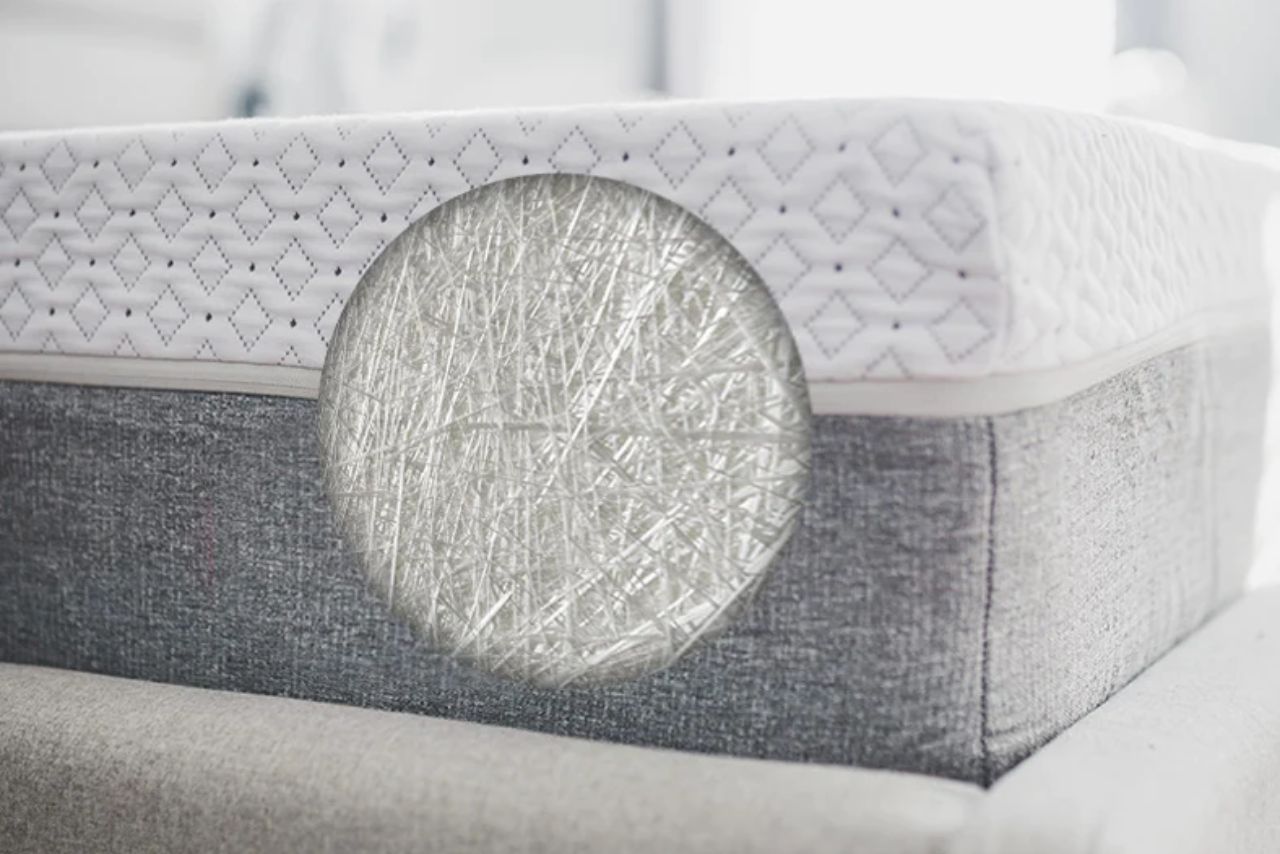
A mattress with fiberglass may sound alarming, but it’s important to understand the facts before jumping to conclusions.
In this article, we will explore the use of fiberglass in mattresses and address any concerns you may have. So,
Mattress With Fiberglass:
A mattress with fiberglass should be avoided as fiberglass particles can become airborne, posing health risks when inhaled, and can be difficult to remove once released. It’s important to choose mattresses without fiberglass for safety and comfort.
It refers to a type of mattress that incorporates small amounts of fiberglass materials within its construction.
Join us as we delve into the details and shed light on the safety measures taken when using fiberglass in mattresses.
What is Fiberglass?
Fiberglass is a lightweight and versatile material made from fine fibers of glass. It has gained popularity in various industries due to its unique properties and uses.
Here are some key points about fiberglass:
- Composition: Fiberglass consists of tiny strands or filaments made from molten glass that are woven together to form a mat-like structure.
- Strength and Durability: Despite its lightweight nature, fiberglass is known for its exceptional strength-to-weight ratio, making it an ideal choice for various applications. It can withstand high levels of stress without easily breaking or deforming.
- Heat Resistance: Fiberglass exhibits excellent heat resistance capabilities, allowing it to withstand high temperatures without melting or losing its structural integrity.
- Electrical Insulation: Due to its non-conductive properties, fiberglass is widely used as an electrical insulator in the manufacturing of circuit boards and other electronic components.
- Corrosion Resistance: Unlike metals that may corrode over time, fiberglass is highly resistant to corrosion caused by moisture, chemicals, and environmental factors such as sunlight exposure.
- Thermal Insulation: The composition of fiberglass provides effective thermal insulation properties by reducing heat transfer between different environments. This makes it suitable for use in insulation materials for buildings and appliances.
- Versatility: Fiberglass can be molded into various shapes using different manufacturing techniques like pultrusion or hand lay-up process, allowing for the creation of complex structures tailored to specific needs.
- Applications: Fiberglass finds extensive application across multiple industries including construction (for roofing panels and reinforcement), automotive (in body parts), aerospace (for aircraft components), marine (boat hulls), sports equipment (skis and surfboards), among others.
In conclusion, fiberglass offers outstanding strength, durability, heat resistance, electrical insulation capability along with versatility in terms of shaping possibilities which make it a valuable material for various industries and applications.
Is There Fiberglass in Your Mattress?
Fiberglass is not typically used as a primary component in mattresses, but it can sometimes be found in certain types of mattresses, specifically those with fire-resistant properties.
Here’s a detailed explanation of fiberglass in mattresses:
- Fire Retardant Barrier: Many mattresses are designed to meet flammability regulations set by various safety standards organizations. To achieve this, manufacturers often incorporate a fire barrier or fire-resistant materials into the mattress construction. Fiberglass is one of the materials that can be used for this purpose.
- Fire Safety Standards: In the United States, for example, mattresses must meet the Federal Flammability Standard (16 CFR Part 1633 and 1632) to reduce the risk of fires. To comply with these standards, manufacturers have to use fire-resistant materials. Fiberglass can be woven into a fire-resistant barrier fabric that is placed inside the mattress cover.
- Layer Placement: If fiberglass is used, it is typically placed beneath the outer fabric cover and above the comfort layers of the mattress. This means that it is not in direct contact with the sleeper, as it is sandwiched between layers of other materials.
- Safety Concerns: While fiberglass can be effective in preventing mattress fires, there are some concerns associated with its use. Fiberglass particles can become airborne if the mattress cover is damaged or if the mattress is torn. These tiny glass fibers are a respiratory irritant and can cause skin irritation if they come into contact with the skin.
- Preventing Exposure: To mitigate the risk of exposure to fiberglass, mattress manufacturers usually encase the fiberglass layer in a barrier fabric that is designed to prevent the release of fiberglass particles. However, if the mattress cover is compromised, such as by a tear or damage, it can lead to fiberglass exposure.
- Handling Damaged Mattresses: If you suspect that your mattress has fiberglass exposure due to damage, it’s important to handle it with care. Vacuum the affected area with a vacuum cleaner equipped with a HEPA filter to capture fiberglass particles. Avoid using the mattress until the issue is resolved.
- Alternatives: If you are concerned about the presence of fiberglass in your mattress, consider looking for mattresses that use alternative fire barrier materials, such as natural fibers like wool or fire-resistant fabrics that do not contain fiberglass.
So, fiberglass may be used in mattresses as a fire-resistant material to comply with safety standards.
However, its use is typically confined to a layer beneath the outer fabric cover, and precautions are taken to prevent the release of fiberglass particles.
If you have concerns about fiberglass exposure, it’s essential to handle damaged mattresses carefully and consider alternatives that use different fire-resistant materials.
Is Fiberglass in Your Mattress Safe?
Fiberglass in a mattress can be a concern for safety and comfort. While fiberglass is often used as a fire barrier in some mattresses, it can pose risks if not properly contained.
- Health Risks: Fiberglass particles are tiny, sharp, and can easily become airborne. Inhaling these particles can irritate the respiratory system and lead to discomfort or health issues such as coughing, itching, and skin irritation. More serious health problems can occur if large amounts of fiberglass are inhaled over a long period.
- Difficulty in Removal: Once fiberglass particles escape from the mattress, they can be incredibly challenging to remove. They can settle into the surrounding environment, including carpets, curtains, and clothing, making cleanup difficult and time-consuming.
- Product Integrity: Over time, wear and tear on a mattress can cause the fiberglass barrier to degrade, allowing the particles to escape. This can happen due to mattress movement, bending, or exposure to moisture.
- Safety Precautions: If you have a mattress that contains fiberglass, it’s crucial to handle it with care. Use a mattress protector or encasement to contain any loose particles. If the mattress cover is compromised, consider replacing the mattress.
- Alternatives: Many mattresses are available without fiberglass fire barriers. Look for options that use alternative fire-resistant materials or natural fire barriers, such as wool. These can provide a safer and more comfortable sleeping environment.
In summary, while fiberglass in a mattress can serve as a fire barrier, it can pose health risks and be challenging to deal with if it escapes.
It’s advisable to choose mattresses without fiberglass to ensure safety and comfort in the long run.
If you have a mattress with fiberglass, take precautions to contain any loose particles and consider replacing it with a safer alternative.
Potential Hazards of Fiberglass:
Fiberglass is commonly used in mattress manufacturing to provide support and insulation.
However, it’s important to be aware of the potential hazards associated with fiberglass:
- Skin Irritation: Direct contact with fiberglass can cause skin irritation, redness, itching, and rashes. The tiny glass fibers can penetrate the skin and lead to discomfort.
- Respiratory Issues: When fiberglass particles become airborne, they can be inhaled into the lungs. Prolonged exposure may result in respiratory problems such as coughing, wheezing, chest tightness, or even more severe conditions like fibrosis.
- Eye Irritation: Fiberglass dust or fibers can irritate the eyes upon contact. It may cause redness, watering of eyes, itchiness, or a gritty feeling.
- Allergic Reactions: Some individuals may develop allergic reactions to fiberglass due to their sensitivity towards certain substances present in its composition. Symptoms can include sneezing,
nasal congestion, watery eyes,
or skin rashes.
It’s crucial for manufacturers and consumers alike to take necessary precautions when dealing with mattresses containing fiberglass:
- Manufacturers should ensure proper containment of loose fibers during production.
- Consumers should handle these mattresses carefully while unpackaging or moving them.
- Use protective clothing (such as gloves) if direct handling is required.
- If any irritation occurs after contact with fiberglass-containing materials,
wash the affected area thoroughly
using mild soap and water.
In summary,
Fiberglass used in mattresses has certain potential hazards including skin irritation,
respiratory issues from inhalation,
eye irritation upon contact,
and possible allergic reactions for some individuals.
Taking appropriate measures during production
and careful handling by consumers
can help minimize these risks significantly
Why Some Mattresses Contain Fiberglass?
When it comes to mattresses, you might be surprised to learn that some of them contain fiberglass.
Here are a few reasons why this material can be found in certain mattress models:
- Fire Retardant Properties: Fiberglass is commonly used as a fire retardant material in mattresses. It helps prevent the rapid spread of flames and reduces the risk of fire hazards.
- Compliance with Safety Regulations: In many countries, including the United States, there are strict regulations regarding flammability standards for consumer products like mattresses. By incorporating fiberglass into their designs, manufacturers ensure compliance with these safety requirements.
- Cost-Effectiveness: Fiberglass is an affordable option for enhancing mattress safety compared to other fire-resistant materials available in the market.
- Durability and Longevity: Mattresses containing fiberglass tend to have increased durability and longevity due to its robust nature. This means your mattress may last longer before needing a replacement.
- Minimal Disruption from Fires: In case of a fire incident, mattresses with fiberglass can help minimize disruptions caused by smoke or burning debris since they resist ignition and slow down combustion.
Although fiberglass provides several benefits when incorporated into mattress construction, it’s important to note that proper handling is crucial:
- Avoid cutting or puncturing the mattress cover: Damaging the cover could release loose fibers.
- Use caution during disposal: If you need to dispose of a fiberglass-containing mattress, follow local guidelines on how to handle potentially hazardous waste appropriately.
- Consider using an additional protective layer: To further reduce any potential contact with loose fibers from within the mattress, adding an extra encasement or protector can provide peace of mind.
Overall, while finding out that your mattress contains fiberglass may initially raise concerns, understanding its purpose and safe usage underscores its importance in meeting regulatory standards for safety without compromising quality or affordability.
Health Concerns with Mattresses containing Fiberglass:
Mattresses containing fiberglass can pose potential health concerns due to the release of tiny glass particles into the air.
These particles can become airborne and be inhaled or come into contact with skin, leading to various health issues.
It is essential for consumers to be aware of these risks before purchasing a mattress that contains fiberglass.
Here are some key health concerns associated with mattresses containing fiberglass:
- Respiratory Irritation: Inhaling glass fibers from a fiberglass-containing mattress can irritate the respiratory system, causing coughing, wheezing, throat irritation, and difficulty breathing.
- Skin Irritation: Direct contact with the microscopic glass fibers may cause itching, redness, rashes, or other forms of skin irritation.
- Eye Irritation: If exposed to fiberglass particles, they can get into your eyes and cause discomfort such as itching, redness, watering eyes or even corneal damage if not promptly addressed.
- Allergic Reactions: Some individuals may develop allergic reactions to fiberglass exposure which could include symptoms like sneezing, runny nose or congestion.
- Ingestion Risks: Although unlikely during regular use of a mattress containing fiberglass; but accidental ingestion (such as when small children put their hands in their mouth after touching contaminated surfaces) could lead to gastrointestinal issues or blockages requiring medical attention.
To minimize these health risks associated with mattresses containing fiberglass:
- Avoid cutting open the mattress cover as it releases more loose fibers.
- Use an allergy-proof encasement designed specifically for trapping microscopic particles.
- Regularly clean your bedding and vacuum around your sleeping area using high-efficiency particulate air (HEPA) filters.
- If you experience persistent symptoms related to fiberglass exposure from your mattress seek medical advice promptly.
It’s important for consumers to make informed decisions about their sleep environment considering both comfort and safety factors. Understanding the potential health concerns associated with mattresses containing fiberglass can help individuals prioritize their well-being and choose alternative bedding options when necessary.
Note: If you suspect your mattress contains fiberglass or have concerns about its safety, it’s best to contact the manufacturer for accurate information and guidance.
How to Identify a Mattress with Fiberglass?
When it comes to identifying a mattress that contains fiberglass, there are several key factors to consider.
By being aware of these indicators, you can ensure that the mattress you choose is free from this potentially hazardous material.
Here’s how to identify a mattress with fiberglass:
- Read product labels: Start by checking the product label or any accompanying documentation provided by the manufacturer. Look for keywords such as “fiberglass-free” or “no fiberglass used.” If the label doesn’t mention anything about fiberglass, it’s essential to dig deeper.
- Check online specifications: Visit the manufacturer’s website or reputable retailers’ websites where they sell mattresses and search for detailed specifications of the product you’re interested in purchasing. Look for information regarding materials used in construction; if it explicitly states no use of fiberglass, you can be more confident in your choice.
- Inspect inside seams and tags: Carefully examine the mattress seams and tags for any warning signs of fiberglass usage. Some manufacturers may include warnings on their products if they contain this material due to legal requirements or customer safety concerns.
- Search consumer reviews: Researching consumer reviews can provide valuable insights into whether a particular mattress brand or model has been known to have issues with fiberglass release. Keep an eye out for common complaints related to fiberglass particles coming through the cover fabric.
- Contact customer support: If you still have doubts about whether a specific mattress contains fiberglass after conducting initial research, reaching out directly to customer support can help clarify any uncertainties before making your purchase decision.
Remember, identifying a mattress with fiberglass is crucial as exposure may lead to skin irritation and respiratory problems if released into the air during normal use or when removing covers for cleaning purposes.
Tips for Dealing with a Mattress Containing Fiberglass:
When it comes to dealing with a mattress containing fiberglass, there are several tips that can help you navigate this situation smoothly.
Here’s what you need to know:
- Avoid Cutting or Ripping the Mattress: Fiberglass particles are commonly found in mattresses designed with fire-resistant properties. To prevent the release of these particles, avoid cutting or ripping the mattress intentionally.
- Use a Protective Cover: Investing in a high-quality protective cover specifically designed for mattresses can be an effective way to contain any potential fiberglass shedding. Look for covers made from tightly woven fabrics that provide an additional layer of protection.
- Regularly Inspect Your Mattress: Perform routine inspections of your mattress to check for signs of damage or wear and tear that could lead to fiberglass exposure. If you notice any issues, address them promptly by repairing or replacing the mattress.
- Handle With Care During Moving: When moving a mattress containing fiberglass, handle it with care to minimize potential particle release. Use proper lifting techniques and ensure it is properly secured during transportation.
- Clean Spills Promptly: In case of liquid spills on your mattress, clean them up immediately using appropriate cleaning methods recommended by the manufacturer. Avoid excessive rubbing or scrubbing as it may cause damage that leads to fiber shedding.
- Minimize Dust Accumulation: Regularly vacuuming your bedroom area and using dust-proof bedding encasements can help reduce dust accumulation on your mattress surface, minimizing the chances of fibers becoming airborne.
- Consult Professional Cleaners if Needed: If you suspect significant contamination or require deep cleaning of your mattress due to other reasons, consider consulting professional cleaners experienced in handling mattresses containing fiberglass safely.
Remember that while these tips can help mitigate risks associated with mattresses containing fiberglass, prevention is always better than cure when it comes to managing potential health concerns related to fiber exposure.
Alternative Mattress Options:
When it comes to choosing a mattress, there are several alternative options available that can provide you with a comfortable and safe sleep environment.
Here are some alternatives to consider:
- Organic Mattresses: Made from natural materials such as organic cotton, wool, or latex, these mattresses are free from harmful chemicals and pesticides. They offer excellent breathability and temperature regulation.
- Memory Foam Mattresses: Memory foam mattresses contour to your body shape, providing excellent support and pressure relief. Look for CertiPUR-US certified memory foam mattresses that have low VOC emissions.
- Latex Mattresses: Latex mattresses offer great comfort and durability while being resistant to dust mites and mold growth naturally. Opt for natural latex derived from sustainable sources.
- Hybrid Mattresses: Hybrid mattresses combine the benefits of different materials like memory foam, latex, or innerspring coils. They often provide an optimal balance between support and comfort.
- Innerspring Mattresses: Traditional innerspring mattresses utilize steel coils for support along with layers of cushioning material on top. Choose models with individually wrapped coils for better motion isolation.
- Airbeds: Adjustable airbeds allow you to customize firmness levels according to your personal preference by inflating or deflating air chambers within the mattress.
- Waterbeds: Water-filled chambers inside waterbeds can conform closely to your body shape while providing gentle support across all areas of your body.
- Bamboo-infused Memory Foam Mattresses: Bamboo-infused memory foam provides improved breathability due to its moisture-wicking properties while offering the same contouring comfort as regular memory foam.
It’s essential when considering alternative mattress options that you prioritize factors such as comfort level, supportiveness, durability, allergen resistance (if applicable), eco-friendliness (if important), and budget.
Conclusion: Mattress With Fiberglass
In conclusion, choosing a mattress with fiberglass is not recommended due to the potential health risks it poses.
Fiberglass particles can become airborne and be inhaled or come into contact with the skin, leading to irritation and respiratory problems.
The presence of fiberglass in a mattress also raises concerns about its overall quality and durability.
When shopping for a mattress, it’s essential to prioritize your health and well-being.
Opting for mattresses made from safer materials such as organic cotton, natural latex, or memory foam can provide a more comfortable sleeping experience without the risk of fiberglass exposure.
Remember that investing in a high-quality mattress is crucial for getting restful sleep and maintaining good overall health. By choosing alternative options without fiberglass, you can ensure that you’re creating a safe and comfortable sleeping environment for yourself and your loved ones.

